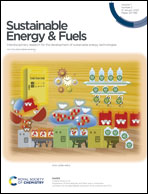A framework for comparing the energy production of photovoltaic modules using 2-, 3-, and 4-terminal tandem cells†
Abstract
One of the design choices to be made when constructing photovoltaic modules from tandem solar cells is whether to use 2-, 3-, or 4-terminal tandem devices. Two-terminal (2T) cells are the simplest to interconnect, but for effective energy production the two subcells must be current-matched, which constrains the choice of materials for the component subcells. Three-terminal (3T) cells can be interconnected in voltage-matched configurations, which greatly increases the number of suitable subcell bandgap combinations, but with some additional cell interconnection complexity and losses. In principle, four-terminal (4T) cells provide the best power production, but in practice this will be mitigated by losses associated with the more complex interconnection requirements and shading losses necessitated by the need to laterally transport carriers between the cells. Many comparisons have been made between 2T and 4T configurations, mostly at the cell level. Here we provide a framework to assess the relative performance of 3T voltage-matched configurations relative to 2T and 4T approaches at the module level. We compare the energy production for both a fixed standard spectrum, and under variable outdoor conditions (accounting for spectrum, temperature, and location). The methods presented enable the comprehensive visualization and comparison of string-end losses, voltage matching ratios, and resistive and optical losses for tandems constructed out of any solar cell materials.



 Please wait while we load your content...
Please wait while we load your content...